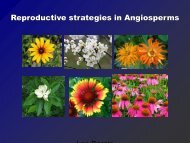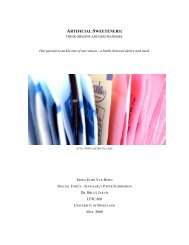Methanogenic - University of Maryland
Methanogenic - University of Maryland
Methanogenic - University of Maryland
Create successful ePaper yourself
Turn your PDF publications into a flip-book with our unique Google optimized e-Paper software.
<strong>Methanogenic</strong> Archaea<br />
and Consortia<br />
Kevin R. Sowers<br />
<strong>University</strong> <strong>of</strong> <strong>Maryland</strong> Biotechnology Institute<br />
Extremophile Research: Theory & Techniques 2003<br />
Hyperthermophiles<br />
Bacteria<br />
Archaea<br />
Crenarchaeota Euryarchaeota<br />
Methanobacterium<br />
Methanobrevibacter<br />
Methanothermus<br />
Methanosaeta<br />
Methanococcus<br />
Methanopyrus<br />
Eukarya<br />
Alessandro Volta<br />
Halophiles<br />
Methanoplanus<br />
Methanospirillum<br />
Methanosarcina<br />
Methanolobus<br />
Methanohalophilus
Volta Experiment<br />
Historical Overview<br />
• 1776 Volta described “combustible air”<br />
• 1806 Henry lamp gas = methane<br />
• 1869 Becamp methanogenesis biological<br />
• 1936 Barker “isolated” M. omelianskii<br />
• 1947 Kluyver first true isolates<br />
• 1950 Hungate anaerobic technique<br />
• 1977 Woese described “archaebacteria”<br />
Phylogeny <strong>of</strong> Methanogens<br />
Boone et al., 1993<br />
Methanococcales<br />
Methanobacteriales<br />
Methanosarcinales<br />
Methanomicrobiales<br />
Methanopyrales
Substrates Used by Orders <strong>of</strong><br />
<strong>Methanogenic</strong> Archaea<br />
• Methanobacteriales H 2 ,HCOOH,H 2 ,HCOOH,H2 /Me, 2 /Me, 2P,2B,CP<br />
• Methanococcales H 2 ,HCOOH<br />
2 ,HCOOH<br />
• Methanomicrobiales H 2 ,HCOOH,E,P,2P,2B,CP<br />
2 ,HCOOH,E,P,2P,2B,CP<br />
• Methanopyrales H 2<br />
• Methanosarcinales H 2 ,CH 2 ,CH3COOH,CH 3COOH,CH3OH,MMA, 3OH,MMA, DMA,TMA,DMS<br />
Characteristics<br />
• psychrophiles (-2.5 OC) - thermophiles (110 O • psychrophiles (-2.5 C)<br />
• acidophiles (pH 5) - alkaliphiles (pH 10.3)<br />
• non-halophiles (
Methanococcoides burtonii<br />
Morphology coccus<br />
Diameter 1.2 µm<br />
Motility Yes<br />
pH optimum/range 7.7/6.8-8.2<br />
Temp optimum 23.4 C/-2.5-30 C<br />
Substrates MeOH/methylamines<br />
Growth factors None<br />
NaCl optimum/range 0.2M/0.2-0.5M<br />
Mol % G+C 39.6<br />
Morphological Diversity<br />
Cell Envelopes<br />
Sprott and Beveridge, 1993<br />
• Methanobacteriaceae pseudomurein<br />
• Methanothermaceae pseudomurein/glycoprotein<br />
• Methanosarcina methanochondroitin/glycoprotein<br />
• Methanococcales protein<br />
• Methanomicrobium mobile protein<br />
• Methanogenium marisnigri protein<br />
• Methanogenium marisnigri glycoprotein<br />
• Methanoplanus limicola glycoprotein<br />
• Methanosaeta concilii glycoprotein/sheath<br />
• Methanosprillum hungatei glycoprotein/sheath
Pseudomurein<br />
Kandler, 1982<br />
Thin-section EM micrograph <strong>of</strong><br />
Methanobacterium thermoautotrophicum<br />
Methanochondroitin<br />
Sprott and Beveridge, 1993<br />
Kreisl and Kandler, 1986
Thin-section EM Micrograph <strong>of</strong><br />
Methanosarcina thermophila<br />
Freeze-etched EM Micrograph <strong>of</strong><br />
Methanocorpusculum sinense<br />
Sprott and Beveridge, 1993<br />
<strong>Methanogenic</strong> Environments<br />
Wolfe, 1996
Anaerobic Digestor / Freshwater Sediments<br />
GROUP I<br />
FERMENTATIVE<br />
BACTERIA<br />
GROUP II<br />
H2-PRODUCING/ CO2 -REDUCING<br />
ACETOGENIC BACTERIA HYDROGEN<br />
FORMATE, CO2 GROUP III<br />
METHANOGENIC<br />
ARCHAEA<br />
COMPLEX POLYMERS<br />
(proteins, polysaccharides, etc.)<br />
MONOMERS/POLYMERS<br />
(sugars, amino acids, peptides)<br />
FATTY ACIDS<br />
PRIMARY ALCOHOLS<br />
AROMATICS<br />
CH 4 , CO 2<br />
ACETATE<br />
Net Effect <strong>of</strong> Interspecies<br />
Hydrogen Exchange<br />
Zinder, 1993<br />
Microstructural Analysis <strong>of</strong> UASB<br />
Granule<br />
Fang et al., 1994, 1995
GROUP I<br />
FERMENTATIVE<br />
BACTERIA<br />
GROUP II<br />
H2-PRODUCING ACETOGENIC BACTERIA<br />
SULFIDOGENIC BACTERIA<br />
GROUP III<br />
METHANOGENIC ARCHAEA<br />
SULFIDOGENIC BACTERIA<br />
GROUP I<br />
FERMENTATIVE<br />
BACTERIA<br />
GROUP III<br />
METHANOGENIC ARCHAEA<br />
Marine Sediments<br />
COMPLEX POLYMERS<br />
(proteins, polysaccharides, etc.)<br />
MONOMERS/POLYMERS<br />
(sugars, amino acids, peptides)<br />
FATTY ACIDS<br />
PRIMARY ALCOHOLS<br />
AROMATICS<br />
HYDROGEN<br />
CO 2<br />
H 2 S, CH 4 ,<br />
CO 2<br />
ACETATE<br />
Animal Rumen<br />
COMPLEX POLYMERS<br />
(proteins, polysaccharides, etc.)<br />
MONOMERS/POLYMERS<br />
(sugars, amino acids, peptides)<br />
HYDROGEN<br />
CO 2<br />
FATTY ACIDS<br />
PRIMARY ALCOHOLS<br />
AROMATICS<br />
RUMINANT<br />
CH 4 , CO 2<br />
ACETATE<br />
Hydrothermal Vents<br />
GROUP III<br />
METHANOGENIC ARCHAEA<br />
HYDROGEN<br />
CO 2<br />
CH 4 , CO 2<br />
METHYLAMINO<br />
METHYLTHIO<br />
OSMOLYTES<br />
METHYLAMINES<br />
METHYL SULFIDES<br />
CH 4 , CO 2
Deep Subsurface Microbial Processes<br />
Kaiser, 1995<br />
Methods - Hungate Technique<br />
Methods - Anaerobic Glove Box<br />
Chamber Chamber<br />
Air lock
Methods - Anaerobic Plating Jar<br />
A B C<br />
Methods - Anaerobic Scale-Up<br />
Genomic Analysis
Archaea<br />
Bacterial characteristics Eukaryal characteristics<br />
•Small molecule biosynthesis<br />
•Intermediary metabolism<br />
•Transport<br />
•Nitrogen fixation<br />
•Regulatory functions<br />
•DNA metabolism<br />
•Transcription<br />
•Translation<br />
Transcription Proteins<br />
Genotypic Genotypic Characteristics Characteristics Undetected<br />
Undetected<br />
in Phenotype Phenotype<br />
• multiple methyltransferases<br />
• flagellin/chemotaxis gene clusters<br />
• cytochrome d oxidase<br />
• 3 nitrogenases (Mo/Fe,V/Fe,Fe)<br />
• unique 2 component reg system
Gene Transfer Systems<br />
Crenarchaeota Euryarchaeota<br />
Desulfurococcus<br />
Pyrodictium<br />
Archaea<br />
Transformation<br />
Halobacterium<br />
Halococcus<br />
Transduction<br />
Methanobacterium<br />
Haloarcula<br />
Conjugation<br />
Methanobrevibacter<br />
Thermoproteus<br />
Methanothermus<br />
Pyrobaculum<br />
Archaeoglobus<br />
Therm<strong>of</strong>ilum<br />
Sulfolobus<br />
Thermococcus<br />
Pyrococcus<br />
Bacteria<br />
Methanococcus<br />
Methanopyrus<br />
Eukarya<br />
Hal<strong>of</strong>erax<br />
Halorubrum<br />
Natronococcus<br />
Natronobacterium<br />
Methanoplanus<br />
Methanospirillum<br />
Methanosarcina<br />
Methanolobus<br />
Methanohalophilus<br />
Methanosaeta<br />
Sowers and Schreier, 1999<br />
Viruses & Virus-like Particles<br />
• ψΜ1 M. thermoautotrophicum lytic<br />
• ΦF3 M. thermoautotrophicum lytic<br />
• ΦF3 M. thermoautotrophicum lytic<br />
• PG M. smithii lytic<br />
• VLP M. voltae temperate<br />
Restriction-Modification Systems<br />
• MaeI, II, III Methanococcus. aeolicus endonuclease<br />
• MthF1, T1, Z1 Methanobacterium endonuclease/<br />
thermoautotropicum methylase<br />
• MvnI Methanococcus vanielii endonuclease<br />
• MwoI Methanobacterium wolfei endonuclease/<br />
methylase<br />
• PstI Methanococcus maripaludis endonuclease
Plasmid DNA<br />
• pT3 Methanobacterium sp. 7.3 kb Unknown function<br />
• pME2001 Methanobacterium thermoautotropicum<br />
4.4 kb Unknown function<br />
• pFV1,2,3 Methanobacterium 13.5,11,11 kb Restriction/<br />
thermoautotropicum methylation<br />
• pURB500 Methanococcus sp 8.7 kb Unknown function<br />
• pURB900 Methanococcus sp. AG86 20 kb Unknown function<br />
• pURB800 Methanococcus jannaschii 64 kb Unknown function<br />
• pURB801 Methanococcus jannaschii 18 kb Unknown function<br />
• pC2A Methanosarcina acetivorans 5.4 kb Recombinase/<br />
replication initiation<br />
• pMP1 Methanolobus vulcanii 6.9 kb Unknown function<br />
M. Acetivorans Native Plasmid<br />
orf1<br />
repA<br />
orf2<br />
0<br />
pC2A<br />
5467bp<br />
ssrA<br />
Selection Cassette<br />
Metcalfe et al, 1997
Hybrid Shuttle Vector<br />
trpA terminator<br />
oriRK6<br />
mcr terminator<br />
pac<br />
mcr promoter<br />
EcoRV (183) BamHI (187) XhoI (265)<br />
bla<br />
lacZ<br />
PWM315<br />
8745bp<br />
pC2A<br />
Ecl136II (233)<br />
EcoICRI (233)<br />
SstI (235)<br />
SacI (235)<br />
Asp718I (240)<br />
Acc65I (240)<br />
KpnI (244)<br />
SphI (253)<br />
ClaI (256)<br />
Metcalf et al., 1997<br />
Shuttle Vector Hybrid Constructs<br />
• pJK series Integration vector Methanosarcina spp.<br />
• pWM series Autonomous vector Methanosarcina spp.<br />
• pWAY1/2 Integration vector Methanosarcina<br />
mazei<br />
• pMIP1 Integration vector Methanococcus voltae<br />
• pKAS Integration vector Methanococcus<br />
maripaludis<br />
• pDLT44 Autonomous vector Methanococcus<br />
maripaludis<br />
Transformation Protocols<br />
• Natural transformation (M. voltae) < 7 x 10 2 /µg<br />
• Electroporation (M. voltae) < 7 x 10 2 /µg<br />
• PEG (M. maripaludis) < 2 x 10 7 /µg<br />
• Liposome (Methanosarcina spp.) < 2 x 10 9 • Natural transformation (M. voltae) < 7 x 10<br />
/µg<br />
2 /µg<br />
• Electroporation (M. voltae) < 7 x 10 2 /µg<br />
• PEG (M. maripaludis) < 2 x 10 7 /µg<br />
• Liposome (Methanosarcina spp.) < 2 x 10 9 /µg
Gene Disruption<br />
•Directed: • Directed: Integration gene disruption<br />
• Random: Ethylmethanesulfonate and<br />
Transposon mutagenesis<br />
Directed Gene Disruption<br />
HisA’<br />
bla<br />
pMIP<br />
pac casette<br />
HisA<br />
HisA’<br />
Methanococcus voltae<br />
Gernhardt et al., 1990<br />
Random Gene Disruption<br />
Zhang et al., 2000
Reporter Vector for Methanosarcina acetivorans<br />
mcrP<br />
pac<br />
oriR6K<br />
mcrT<br />
C2A<br />
bla<br />
1<br />
pKJ104<br />
12994bp<br />
lacZ<br />
Current Limitations<br />
• Limited genetic selection markers<br />
• DNA restriction/modification systems<br />
• DNA repair/recombination mutants<br />
cdhP<br />
Sowers et al.<br />
Current Capabilities<br />
• Genomes sequenced<br />
• Integration/autonomous plasmid vectors<br />
• Transposon mutagenesis<br />
• Reporter plasmids<br />
Technological Applications<br />
• Human/animal waste treatment<br />
• Energy production<br />
• Bioremediation<br />
• Thermostable enzymes<br />
• Thermostable lipids<br />
• Synthesis <strong>of</strong> other unique compounds




